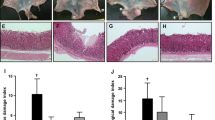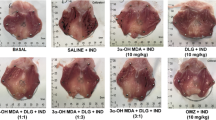Abstract
Cilostazol, a selective type III phosphodiesterase inhibitor, is widely used for treatment of ischemic symptoms of peripheral vascular disease. Recent studies have reported that the mechanism of cilostazol is related to suppression of pro-inflammatory cytokine production and improvement of local microcirculation disturbances. The activation of inflammatory cells and pro-inflammatory cytokine production play critical roles in the pathogenesis of aspirin-induced gastric irritation. The aim of the present study was to determine whether cilostazol can ameliorate aspirin-induced gastric mucosal lesions in rats, reduce neutrophil accumulation, and reduce the production of pro-inflammatory cytokines. Gastric lesions were produced by oral gavage of aspirin (200 mg/kg) and HCl (0.15 N, 8.0 ml/kg). Cilostazol (1–10 mg/kg, IP) was injected 30 min before aspirin administration. Also, we measured the gastric mucosal concentrations of myeloperoxidase and interleukin-1 β, tumor necrosis factor-α, and cytokine-induced neutrophil chemoattractants-1, as an index of neutrophil accumulation, and the pro-inflammatory cytokines. Cilostazol ameliorated the gastric mucosal lesions induced by aspirin administration (P < 0.01). The gastric contents of myeloperoxidase and pro-inflammatory cytokines were all increased after aspirin administration and significantly reduced by cilostazol treatment. In this study, we demonstrated that a selective type III phosphodiesterase inhibitor, cilostazol, reduced aspirin-induced gastric inflammation and damage via suppression of the production of proinflammatory cytokines. Cilostazol may be useful for preventing gastric mucosal lesions induced by aspirin.
Similar content being viewed by others
References
Hall J, Morand EF, Medbak S, Zaman M, Perry L, Goulding NJ, Maddison PJ, O'Hare JP (1994) Abnormal hypothalamic-pituitary-adrenal axis function in rheumatoid arthritis. Effects of nonsteroidal antiinflammatory drugs and water immersion. Arth Rheum 37:1132–1137
Rashad S, Revell P, Hemingway A, Low F, Rainaford K, Walker F (1989) Effect of nonsteroidal anti-inflammatory drugs on the course of osteoarthritis. Lancet 8662:519–522
Beck PL, Xavier R, Lu N, Nanda NN, Dinauer M, Podolsky DK, Seed B (2000) Mechanism of NSAIDs-induced gastrointestinal injury defined using mutant mice. Gastroenterology 119:699–705
Yoshikawa T, Naito Y, Kishi A, Tomii T, Kaneko T, Iinuma S, Ichikawa H, Yasuda M, Takahashi S, Kondo M (1993) Role of active oxygen, lipid peroxidation, and antioxidants in the pathogenesis of gastric mucosal injury induced by indomethacin in rats. Gut 34:732–737
Takeuchi K, Ueshima K, Hironaka Y, Fujioka Y, Matsumoto J, Okabe S (1991) Oxygen free radicals and lipid peroxidation in the pathogenesis of gastric mucosal lesions induced by indomethacin in rats. Relation to gastric hypermotility. Digestion 49:175–184
Andrews FJ, Malcontenti-Wilson C, O’Brien PE (1994) Effect of nonsteroidal anti-inflammatory drugs on LFA-1 and ICAM-1 expression in gastric mucosa. Am J Physiol 266:G657–G664
Wallace JL, Keenan CM, Granger DN (1990) Gastric ulceration induced by nonsteroidal anti-inflammatory drugs is a neutrophil-dependent process. Am J Physiol 259:G462–G467
Yoshida N, Yoshikawa T, Nakamura Y, Arai M, Matsuyama K, Iinuma S, Yagi N, Naito Y, Miyasaka M, Kondo M (1995) Role of neutrophil-mediated inflammation in aspirin-induced gastric mucosal injury. Dig Dis Sci 40:2300–2304
Kambayashi J, Liu Y, Sun B, Shakur Y, Yoshitake M, Czerwiec F (2003) Cilostazol as a unique antithrombotic agent. Curr Pharm Design 9:2289–2302
Liu Y, Shakur Y, Yoshitake M, Kambayashi J (2001) Cilostazol: a dual inhibitor of cyclic nucleotide phosphodiesterase type 3 and adenosine uptake. Cardiovasc Drug Rev 19:369–386
Moore AR, Willoughby DA (1995) The role of cAMP regulation in controlling inflammation. Clin Exp Immunol 101:387–389
Shin HK, Kim YK, Kim KY, Lee JH, Hong KW (2004) Remnant lipoprotein particles induce apoptosis in endothelial cells by NAD(P)H oxidase-mediated production of superoxide and cytokines via lectin-like oxidized low-density lipoprotein receptor-1 activation prevention by cilostazol. Circulation 109:1022–1028
Omi H, Okayama N, Shimizu M, Fukutomi T, Nakamura A, Imaeda K, Okouchi M, Itoh M (2004) Cilostazol inhibits high glucose-mediated endothelial-neutrophil adhesion by decreasing adhesion molecule expression via NO production. Microvasc Res 68:119–125
Ohba R, Otaka M, Odashima M, Jin M, Komatsu K, Konishi N, Wada I, Horikawa Y, Matsuhashi T, Oyake J, Hatakeyama N, Watanabe S (2006) Effect of cilostazol, a selective type III phosphodiesterase inhibitor, on water-immersion stress-induced gastric mucosal injury in rats. J Gastroenterol 41(1):34–40
Brodie DA, Hanson HW (1960) A study of the factors involved in the production of gastric ulcers by restraint technique. Gastroenterology 38:353–361
Bradford MM (1976) A rapid and sensitive method for the quantitation of microgram quantities of protein utilizing the principle of protein-dye binding. Anal Biochem 72:248–254
Bradley PP, Priebat DA, Christensen RD, Rothstein G (1982) Measurement of cutaneous inflammation: estimation of neutrophil content with the enzyme marker. J Invest Dermatol 78:206–209
Toroudi HP, Rahgozar M, Bakhtiarian A, Djahanguiri B (1999) Potassium channel modulatora and indomethaxin-inducde gastric ulceration in rats. Scand J Gastroenterol 34:962–966
Santucci L, Fiorucci M, Giansanti M, Brunori PM, Di Matteo FM, Morelli A (1995) Role of tumor necrosis factor α release and leukocyte margination in indomethaxin-induced gastric injury in rats. Gastroenterology 108:393–401
Stephen JB, Morise Z, Sven T, Laureen M, Granger DN, Matthew BG (1999) Role of the proteasome in rat indomethacin-induced gastropathy. Gastroenterology 116:865–873
Mulligan MS, Johnson KJ, Todd III RF, Issekutz TB, Miyasaka M, Tamatani T, Smith CW, Anderson DC, Ward PA (1993) Requirements for leukocyte adhesion molecules in nephrotoxic nephritis. J Clin Invest 91:577–587
Hamaguchi M, Watanabe T, Higuchi K, Tominaga K, Fujiwara Y, Arakawa T (2001) Mechanisms and roles of neutrophil infiltration in stress-induced gastric injury in rats. Dig Dis Sci 46:2708–2715
Santucci L, Fiorucci M, Giansanti M, Brunori PM, Di Matteo FM, Morelli A (1994) Pentoxifylline prevents indomethacin induced acute gastric mucosal damage in rats: role of tumor necrosis factor alpha. Gut 35:909–915
Yoshikawa T, Takano H, Naito Y, Oyamada H, Ueda S, Kondo M (1992) Augmentative effects of tumor necrosis factor-alpha (human, natural type) on polymorphonuclear leukocyte-derived superoxide generation induced by various stimulants. Int J Immunopharmacol 14:1391–1398
Kokura S, Wolf RE, Yoshikawa T, Granger DN, Aw TY (2000) T-lymphocyte-derived tumor necrosis factor exacerbates anoxia-reoxygenation-induced neutrophil-endothelial cell adhesion. Circ Res 86:205–213
Kahky MP, Daniel CO, Cruz AB, Gaskill HV 3rd (1990) Portal infusion of tumor necrosis factor increases mortality in rats. J Surg Res 49:138–145
Acknowledgment
The authors wish to express their thanks to Otsuka Pharmaceutical Co., Ltd., Tokyo, for the gift of cilostazol
Author information
Authors and Affiliations
Corresponding author
Additional information
*These authors contributed equally to this work.
Rights and permissions
About this article
Cite this article
Odashima*, M., Otaka*, M., Ohba*, R. et al. Attenuation of Gastric Mucosal Inflammation Induced by Aspirin Through Inhibition of Selective Type III Phospshodiesterase in Rats. Dig Dis Sci 52, 1355–1359 (2007). https://doi.org/10.1007/s10620-006-9553-y
Received:
Accepted:
Published:
Issue Date:
DOI: https://doi.org/10.1007/s10620-006-9553-y




